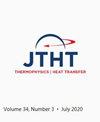等离子体风洞中非平衡流动的计算与实验研究
IF 1.7
4区 工程技术
Q4 ENGINEERING, MECHANICAL
引用次数: 0
摘要
本工作通过实验和计算研究了等离子体风洞设备自由流和冲击层中的热化学非平衡流动。计算研究是使用开源求解器[公式:见正文]进行的,该求解器使用NASA交互加热设施案例进行了验证。使用两个化学反应模型来计算空气的非平衡状态,空气由六种物质组成([公式:见正文],[公式:参见正文],NO,N,O,Ar)。光学发射光谱用于实验捕获[公式:见正文]自由流的第一个正系统发射和冲击区的分子CN振动带发射。采用玻尔兹曼图方法从测量的光谱中估计振动温度。[公式:见正文]的两个不同跃迁在自由流中测得的振动温度彼此一致,这表明在本研究中考虑的条件下,振动模式服从玻尔兹曼分布。在等离子体风洞条件下,使用[公式:见正文]计算的喷嘴自由流和冲击层中的振动温度与从光学发射光谱获得的值一致。本文章由计算机程序翻译,如有差异,请以英文原文为准。
Computational and Experimental Study of Nonequilibrium Flow in Plasma Wind Tunnel
The present work examines the thermochemical nonequilibrium flow in the freestream and shock layer of the Plasma Wind Tunnel Facility using experiments and computations. Computational studies were performed using the open-source solver [Formula: see text], which was validated using the NASA Interaction Heating Facility case. Two chemical reaction models were used to compute the nonequilibrium state of air, composed of six species ([Formula: see text], [Formula: see text], NO, N, O, Ar). Optical emission spectroscopy was employed to experimentally capture the [Formula: see text] first positive system emission from the freestream and molecular CN vibration bands emissions in the shock region. The Boltzmann plot method was employed to estimate the vibrational temperatures from the measured spectra. The measured vibrational temperatures in the freestream for two different transitions of [Formula: see text] agree with one another, which shows that the vibrational modes obey the Boltzmann distribution for the conditions considered in this study. The vibrational temperatures computed using [Formula: see text] in the nozzle freestream and the shock layer for the Plasma Wind Tunnel conditions agree with the values obtained from optical emission spectroscopy.
求助全文
通过发布文献求助,成功后即可免费获取论文全文。
去求助
来源期刊

Journal of Thermophysics and Heat Transfer
工程技术-工程:机械
CiteScore
3.50
自引率
19.00%
发文量
95
审稿时长
3 months
期刊介绍:
This Journal is devoted to the advancement of the science and technology of thermophysics and heat transfer through the dissemination of original research papers disclosing new technical knowledge and exploratory developments and applications based on new knowledge. The Journal publishes qualified papers that deal with the properties and mechanisms involved in thermal energy transfer and storage in gases, liquids, and solids or combinations thereof. These studies include aerothermodynamics; conductive, convective, radiative, and multiphase modes of heat transfer; micro- and nano-scale heat transfer; nonintrusive diagnostics; numerical and experimental techniques; plasma excitation and flow interactions; thermal systems; and thermophysical properties. Papers that review recent research developments in any of the prior topics are also solicited.
 求助内容:
求助内容: 应助结果提醒方式:
应助结果提醒方式:


